Introduction
Across every industry, businesses are grappling with unprecedented challenges: tighter margins, surging customer expectations, and operational inefficiencies. Artificial Intelligence (AI) is emerging as a cross-sector solution automating workflows, extracting insights from data, and driving smarter, faster decisions. This guide breaks down how AI is transforming a variety of industries, each with its own unique demands and high-impact use cases.
What is AI and Why It Matters in Different Industries?
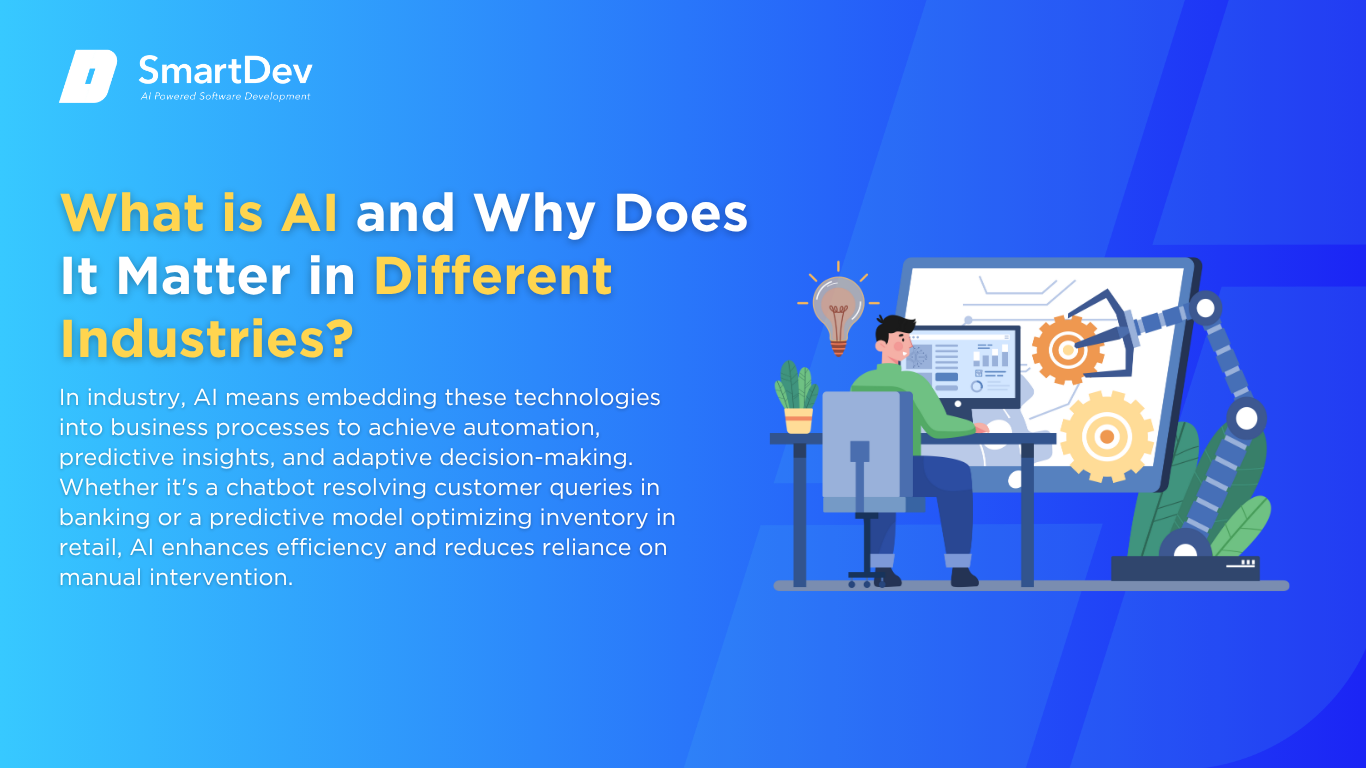
Definition of AI and Its Core Technologies
AI refers to the simulation of human intelligence by machines – systems capable of learning, reasoning, and problem-solving. Core AI technologies include machine learning (ML), natural language processing (NLP), and computer vision. These enable systems to analyze vast data sets, interpret language, and recognize patterns, images, or anomalies.
In industry, AI means embedding these technologies into business processes to achieve automation, predictive insights, and adaptive decision-making. Whether it’s a chatbot resolving customer queries in banking or a predictive model optimizing inventory in retail, AI enhances efficiency and reduces reliance on manual intervention.
The Growing Role of AI in Transforming Different Industries
AI is redefining how companies operate, compete, and serve customers. In manufacturing, AI predicts equipment failures before they happen, minimizing downtime. In healthcare, AI improves diagnostic accuracy and enables personalized treatments. In finance, it powers fraud detection and risk assessment.
In retail, AI customizes product recommendations, improves inventory planning, and streamlines checkout experiences. Logistics firms leverage AI to dynamically reroute shipments and optimize warehouse operations. Educational institutions use AI for adaptive learning platforms and virtual tutoring, tailoring education to individual needs.
AI’s growing accessibility via cloud platforms, open-source tools, and pre-trained models means that even small and mid-sized organizations can deploy advanced capabilities. As AI shifts from experimental to essential, industries that adapt quickly are positioned to gain competitive advantage.
Key Statistics and Trends in AI Adoption in Different Industries
AI adoption is accelerating across sectors. According to IBM’s 2023 Global AI Adoption Index, 40% of IT professionals at large organizations report that they have actively deployed AI, and an additional 40% are exploring it. Sectors like IT, finance, and manufacturing lead in implementation, while healthcare and logistics are rapidly catching up.
A McKinsey report notes that early AI adopters in manufacturing have seen efficiency gains of 20% and defect rate reductions of up to 30%. In retail, companies using AI-driven personalization achieved an average sales increase of approximately 20%, as shown by data from Boston Consulting Group.
The global market for AI is projected to reach $407 billion by 2027, growing at a CAGR of 36.2%, according to MarketsandMarkets. This surge reflects both the maturing of AI technologies and the urgency industries face to modernize operations and decision-making.
Business Benefits of AI in Different Industries
AI is solving industry-specific challenges with high precision. Below are five key business benefits AI is delivering across different sectors, each directly tied to operational improvement and strategic growth.
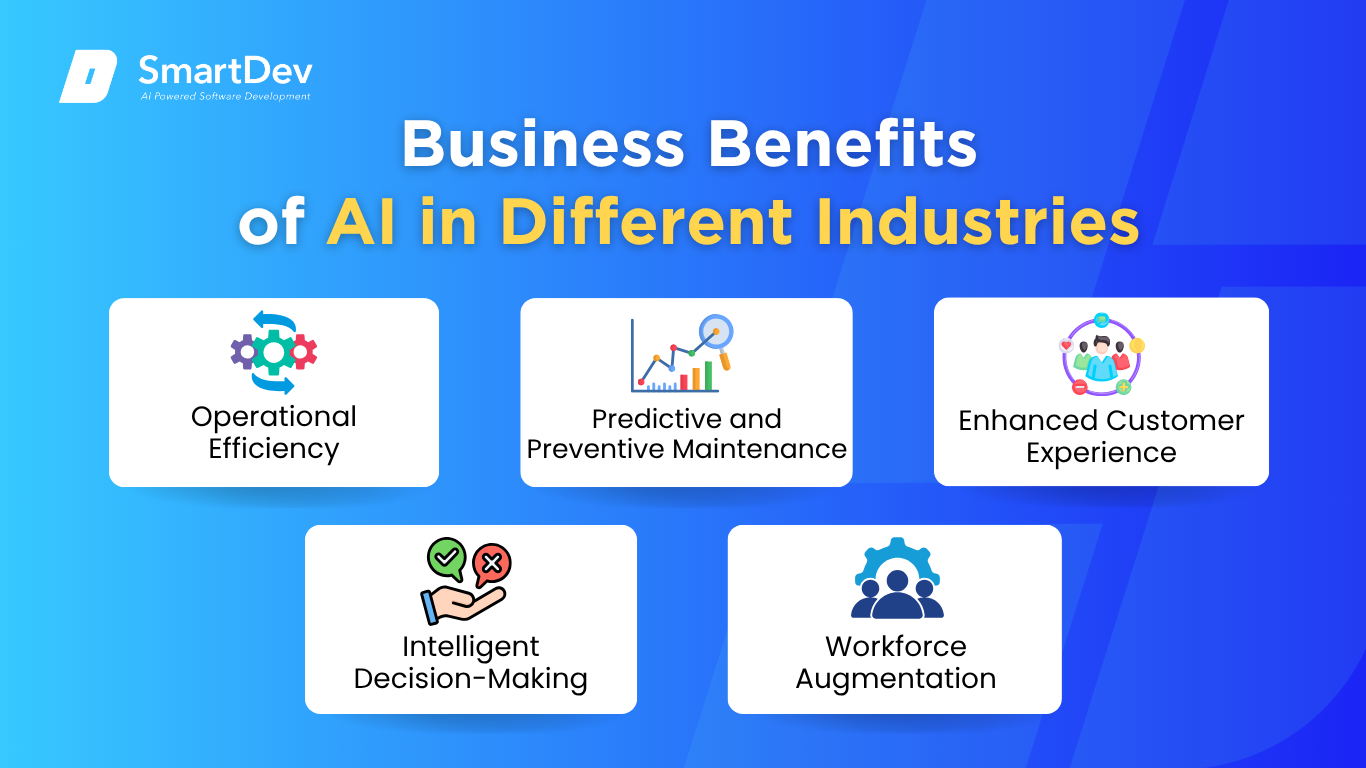
1. Operational Efficiency
Industries are increasingly reliant on AI to automate repetitive, time-consuming tasks. In finance, AI handles invoice processing and compliance checks, drastically reducing processing times. In manufacturing, robotic process automation (RPA) powered by AI improves assembly line productivity.
AI systems also streamline backend operations. For example, in HR, AI shortlists job candidates by scanning resumes and matching qualifications with job descriptions, reducing time-to-hire. In logistics, AI systems automate load planning and documentation.
2. Predictive and Preventive Maintenance
AI is helping industries shift from reactive to proactive maintenance strategies by enabling early detection of potential issues. In sectors like aviation and heavy manufacturing, machine learning algorithms analyze sensor data to identify wear and tear before it causes failures. This capability helps avoid unplanned downtime and enhances operational safety.
In the utilities sector, AI systems continuously monitor infrastructure to detect real-time anomalies and performance deviations. These alerts enable timely interventions that prevent larger service disruptions. The predictive nature of these systems extends asset life and reduces total maintenance costs over time.
3. Enhanced Customer Experience
AI personalizes customer interactions by analyzing behavior, preferences, and past transactions. In e-commerce, AI-driven recommendation engines increase engagement and raise average cart value. In banking, AI chatbots and virtual agents provide 24/7 support, responding to inquiries instantly and improving service efficiency.
Retailers rely on AI to forecast demand, which helps balance inventory and ensure timely deliveries. These enhancements boost customer satisfaction and build brand loyalty over time. In the telecom sector, AI predicts potential churn by identifying dissatisfied customers early and recommending proactive interventions.
4. Intelligent Decision-Making
AI enhances decision quality by delivering real-time insights from both structured and unstructured data. In financial services, it aids portfolio management and helps assess credit risk with more accuracy. In healthcare, AI contributes to treatment planning by analyzing patient history and genomic data.
Marketing departments use AI-driven sentiment analysis to shape messaging and optimize campaign performance. In supply chain management, AI forecasts demand and enhances logistics planning for improved responsiveness. These capabilities result in smarter, faster, and more strategic decisions across industries.
5. Workforce Augmentation
Rather than replacing human workers, AI often augments their capabilities. In law, AI helps paralegals and lawyers sift through large volumes of case law quickly. In journalism, AI drafts basic reports that editors refine.
In education, AI tutors supplement classroom instruction and offer students personalized practice. Across industries, AI allows professionals to focus on higher-order tasks by taking over administrative and analytical burdens.
Challenges Facing AI Adoption in Different Industries
Despite the momentum, AI adoption is not without obstacles. Here are five critical challenges organizations face, each requiring strategic planning and cross-functional coordination to overcome.
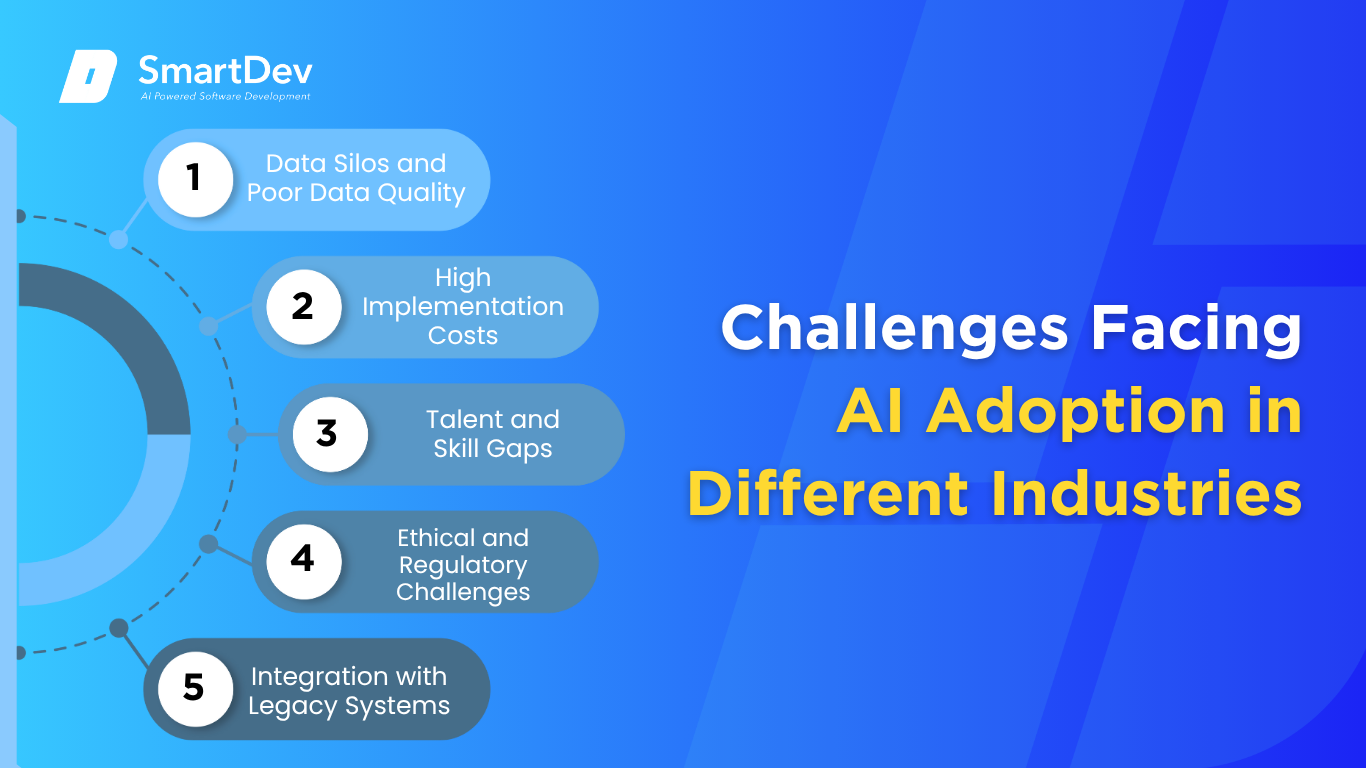
1. Data Silos and Poor Data Quality
AI systems depend on clean, well-integrated data. Many organizations suffer from siloed databases and inconsistent data formats, making AI training difficult and error-prone. In healthcare, for instance, fragmented EHR systems hinder effective AI use in diagnostics.
Establishing unified data governance and infrastructure is a prerequisite for AI success. It requires cross-department collaboration, investment in data engineering, and a culture of data accountability.
2. High Implementation Costs
The upfront cost of implementing AI can be prohibitive, particularly for organizations lacking economies of scale. Developing custom AI models requires large datasets, advanced computing infrastructure, and highly specialized talent. These costs often discourage smaller businesses from initiating AI projects despite the long-term benefits.
To mitigate this, many companies turn to cloud-based AI services and pre-trained models that lower the entry barrier. While these tools reduce some development overhead, integration with existing systems still incurs cost and complexity. Additionally, internal teams must be equipped with the skills to adapt and scale AI tools effectively.
3. Talent and Skill Gaps
AI adoption is frequently stalled due to a lack of in-house expertise capable of managing advanced technologies. Many organizations struggle to find data scientists, machine learning engineers, and technically fluent managers who can operationalize AI solutions. This shortage creates a disconnect between business goals and the technical execution required for AI success.
To address this, companies are focusing on upskilling existing employees and seeking external partnerships with AI consultants. Training programs and reskilling initiatives can help close the talent gap if aligned with long-term strategy. However, without a structured workforce plan, these efforts often remain reactive and insufficient.
4. Ethical and Regulatory Challenges
Industries handling sensitive data—like finance, healthcare, and education—face heightened scrutiny over AI’s ethical use. Bias in algorithms, data privacy breaches, and lack of explainability raise compliance risks.
Governments are moving to regulate AI, such as the EU AI Act and U.S. federal frameworks. Companies must proactively address these concerns with transparent practices, fairness audits, and ethical AI policies.
5. Integration with Legacy Systems
Many enterprises still operate on outdated legacy infrastructure, creating significant hurdles for AI implementation. This incompatibility slows down deployment, creates friction, and limits the scalability of AI solutions. For instance, financial institutions often rely on mainframes that are not designed to support modern AI applications.
To overcome these barriers, companies must invest in phased modernization strategies. Modular AI tools and APIs can serve as bridges between legacy systems and new platforms, allowing gradual upgrades without operational disruption. Success depends on a clear roadmap that balances innovation with business continuity.
Specific Applications of AI in Different Industries
From smart diagnostics in healthcare to dynamic pricing in retail, AI is transforming how industries operate and deliver value. This section explores six high-impact applications of AI across various sectors, illustrating how intelligent systems streamline operations, boost productivity, and reduce risks.
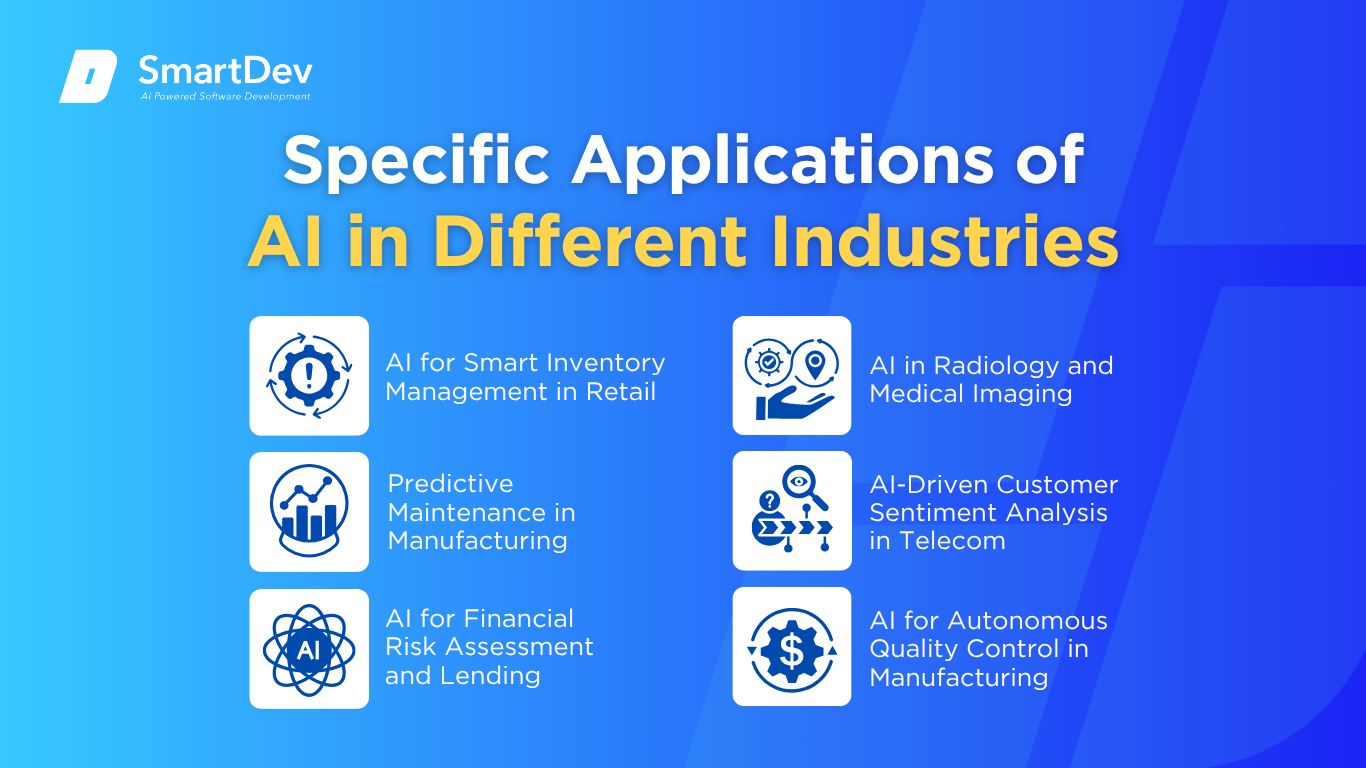
1. AI for Smart Inventory Management in Retail
AI systems in retail use real-time analytics and predictive modeling to optimize inventory levels. By analyzing sales trends, customer behavior, and seasonal patterns, these models ensure shelves are stocked efficiently while reducing overstock and stockouts. Retailers benefit from reduced holding costs, improved customer satisfaction, and leaner supply chains.
The underlying AI models ingest data from POS systems, supplier inputs, and historical demand, using time-series forecasting and anomaly detection. They recommend replenishment strategies, highlight slow-moving items, and even trigger auto-reorders. Retail teams integrate these tools into ERP platforms for seamless inventory workflows.
A notable case is Walmart’s use of AI and machine learning in its demand planning systems. Walmart’s algorithmic forecasting platform helps maintain optimal inventory and reduce waste, resulting in improved in-stock rates and a better shopping experience for customers.
2. Predictive Maintenance in Manufacturing
Manufacturers are leveraging AI to predict machine failures before they occur, minimizing downtime and avoiding costly repairs. Predictive maintenance solutions analyze sensor data to detect early signs of wear, temperature anomalies, and vibration patterns. This proactive approach replaces traditional maintenance cycles with just-in-time servicing.
These AI systems use machine learning algorithms trained on historical maintenance records and IoT sensor data. Models forecast component failure probabilities and generate alerts for timely intervention. Integration with MES (Manufacturing Execution Systems) ensures alignment with operational processes.
GE Appliances, a subsidiary of Haier, implemented predictive maintenance in their smart factories using AI-driven analytics. The initiative reduced unplanned equipment failures by 20% and saved millions in maintenance costs annually.
3. AI for Financial Risk Assessment and Lending
In finance, AI algorithms improve credit scoring, risk analysis, and loan approvals. Unlike traditional models that rely on limited credit history, AI incorporates alternative data sources such as transaction behavior, digital footprints, and social media activity. This expands financial access while lowering default risks.
The models apply supervised learning techniques on labeled datasets of borrower profiles and repayment outcomes. Natural language processing helps parse unstructured financial documents, while anomaly detection flags fraudulent applications. AI tools are embedded into digital lending platforms and banking apps.
Upstart, a fintech company, uses AI to automate loan approvals and assess borrower risk more inclusively. The company reports that their model approves 27% more borrowers than traditional models with 16% lower average APRs for approved loans.
4. AI in Radiology and Medical Imaging
AI-driven image recognition tools assist radiologists by identifying anomalies in X-rays, CT scans, and MRIs with high precision. These tools reduce diagnostic errors and accelerate clinical workflows by highlighting potential issues for human review. This is especially impactful in early detection of cancer, fractures, and neurological conditions.
Deep learning algorithms trained on vast annotated datasets detect patterns and abnormalities at a pixel level. These tools are integrated into hospital PACS (Picture Archiving and Communication Systems) to enhance the radiologist’s efficiency. Decision-support systems also provide probability scores and recommendations.
Qure.ai is an example of a medtech startup using AI for interpreting chest X-rays and brain CTs. Deployed in over 20 countries, Qure.ai’s platform has reduced radiology backlogs and provided faster triage in emergency cases, especially in underserved regions.
5. AI-Driven Customer Sentiment Analysis in Telecom
Telecommunication companies use AI to gauge customer sentiment and reduce churn by analyzing call center transcripts, social media, and service feedback. Sentiment models detect dissatisfaction signals and escalate high-risk cases for proactive retention. This enhances customer loyalty and brand reputation.
Natural language processing techniques extract emotions, topics, and sentiment scores from large text corpora. These insights feed into CRM systems and customer support dashboards to guide agent responses and trigger targeted retention campaigns.
Vodafone implemented AI-powered sentiment analysis to improve their customer experience across digital channels. As a result, they saw a 15% drop in churn and improved net promoter scores (NPS) due to timely intervention.
6. AI for Autonomous Quality Control in Manufacturing
AI-driven computer vision systems now perform real-time product inspections on assembly lines. These tools identify defects such as surface blemishes, misalignments, or missing components faster and more accurately than human inspectors. This enhances product consistency and reduces rework costs.
The systems use convolutional neural networks (CNNs) trained on defect image libraries and operational data. Integrated with robotics, they automatically sort defective items and alert technicians. This closed-loop feedback ensures continuous process improvement.
Foxconn has deployed AI vision systems in its electronics manufacturing plants to detect micro-defects in circuit boards and phone parts. The implementation improved defect detection accuracy by 35% and cut inspection time by over 60%, resulting in faster throughput and better product quality.
Need Expert Help Turning Ideas Into Scalable Products?
Partner with SmartDev to accelerate your software development journey — from MVPs to enterprise systems.
Book a free consultation with our tech experts today.
Let’s Build TogetherExamples of AI in Different Industries
The previous section explored core AI applications across sectors; now let’s dive into four detailed case studies that demonstrate how AI is transforming operations in healthcare, finance, retail, and manufacturing.
Real-World Case Studies

1. IBM Watson Health: AI for Diagnostics and Clinical Decision Support
IBM Watson Health exemplifies how AI is used in medical diagnostics and treatment planning. Watson analyzes vast volumes of medical literature, patient records, and clinical data to assist doctors in making evidence-based decisions. It supports radiologists by interpreting diagnostic images such as MRIs and CT scans with high accuracy, thus reducing manual workloads.
In one prominent case, Watson was deployed in a hospital network to automate the analysis of breast cancer imaging and patient records. By cross-referencing symptoms and treatment history with clinical guidelines, Watson suggested tailored care plans. The result was a reported 30% improvement in diagnostic speed and better alignment with oncology best practices, contributing to faster patient onboarding and improved care outcomes.
2. JPMorgan Chase: AI for Financial Fraud Detection and Compliance
JPMorgan Chase utilizes AI to combat financial fraud and ensure regulatory compliance across its global operations. AI models scan millions of transactions daily, identifying patterns that suggest money laundering, account takeovers, or unauthorized access. The use of neural networks allows the system to adapt to evolving fraud tactics in near real time.
The company’s proprietary platform, COiN (Contract Intelligence), also automates document review for loan agreements and compliance checks. COiN reviewed 12,000 agreements in seconds, a task that would take legal teams thousands of hours. JPMorgan reported a 50% reduction in false positives and significant operational cost savings while boosting compliance speed and accuracy.
3. Amazon: AI for Retail Personalization and Virtual Shopping Assistants
Amazon’s AI ecosystem enhances every part of its retail pipeline, particularly through advanced recommendation engines and voice-enabled assistants. By processing massive behavioral datasets, Amazon personalizes product suggestions, search results, and promotions, creating a seamless shopping experience.
More recently, Amazon launched Rufus, a generative AI assistant that answers product questions, recommends gifts, and supports curated shopping. The assistant integrates product reviews, specifications, and user data to provide tailored advice. Amazon observed a 10% lift in click-through and conversion rates following Rufus deployment, highlighting the commercial impact of real-time personalized AI guidance.
4. Siemens: AI-Driven Predictive Maintenance in Manufacturing
Siemens employs AI in smart factories to perform predictive maintenance and reduce operational downtime. Sensor data from machinery is fed into machine learning models that forecast wear-and-tear, mechanical failures, and energy inefficiencies before they occur. This helps preempt costly disruptions in production lines.
In one deployment at a European plant, Siemens integrated AI with its IoT platform, MindSphere, to monitor over 500 machines in real time. The AI system identified motor overheating patterns and alerted technicians ahead of failure. The initiative resulted in a 25% drop in unscheduled downtime and a 15% improvement in machine lifespan, boosting productivity and reducing maintenance costs.
Innovative AI Solutions
Emerging AI technologies continue to reshape application support by introducing enhanced automation and intelligence. Advanced natural language understanding allows chatbots to handle increasingly complex interactions, improving user satisfaction. Meanwhile, AI-powered anomaly detection models are becoming more accurate, enabling near real-time problem detection.
These solutions drive a shift towards predictive and autonomous IT operations, where AI not only assists but also anticipates and resolves issues proactively. This transformation reduces human intervention, cuts operational costs, and increases system reliability. Businesses adopting these innovations gain a competitive edge by delivering superior, uninterrupted application experiences.
AI-Driven Innovations Transforming Different Industries
Emerging Technologies in AI for Different Industries
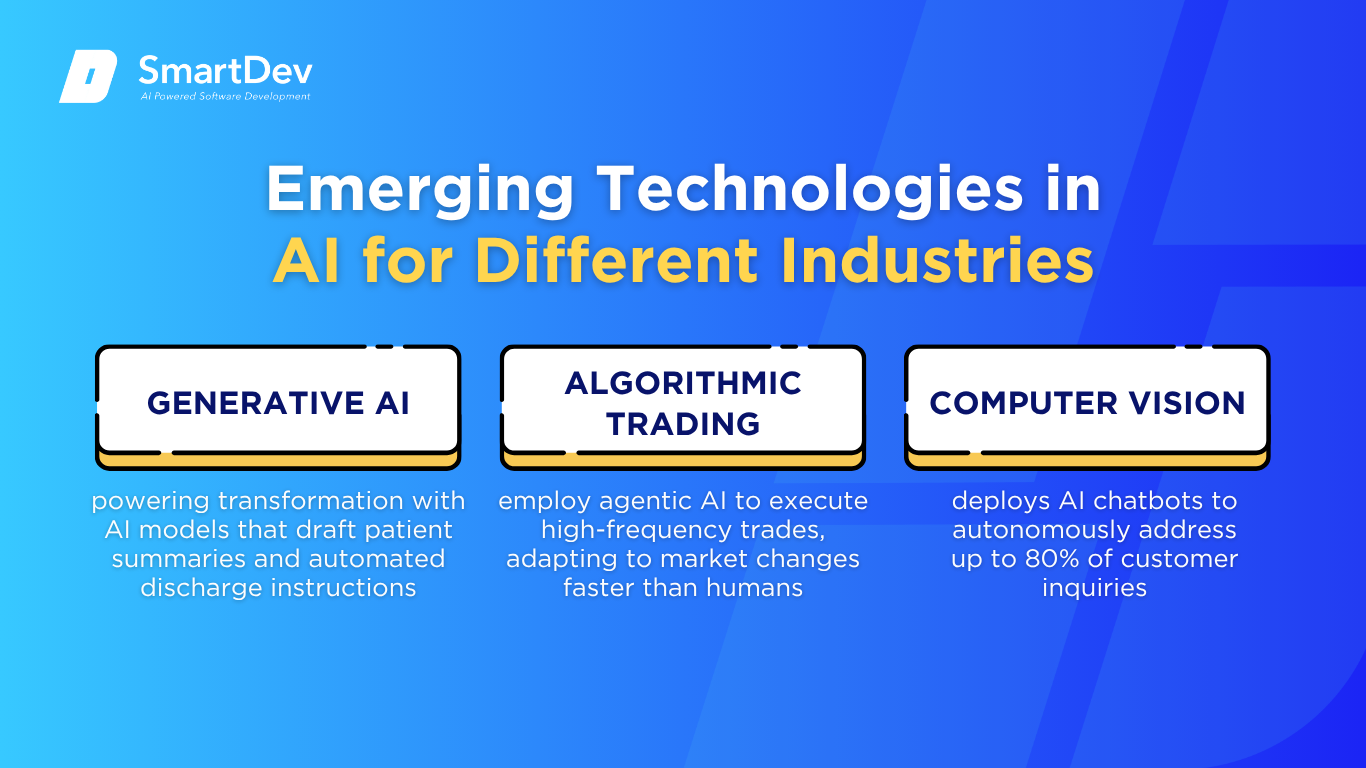
Generative AI is powering transformation in healthcare with AI models that draft patient summaries and automated discharge instructions. This personalization accelerates clinician workflows and enhances patient care quality. Computer vision tools are increasingly used in radiology; deep learning excels at detecting anomalies in mammograms and MRIs, reducing diagnostic errors and speeding up throughput.
In finance, AI fuels fraud and anomaly detection via neural networks that flag abnormal transactions in real time. Algorithmic trading platforms employ agentic AI to execute high-frequency trades, adapting to market changes faster than humans. Additionally, AI-driven credit underwriting tools provide rapid scoring for customers with limited credit histories, improving access while reducing risk.
Retail harnesses generative AI to power personalized recommendation engines (e.g., Amazon, Netflix), boosting customer engagement. Computer vision manages inventory tracking and shelf monitoring like Walmart deploys AI chatbots to autonomously address up to 80% of customer inquiries. In manufacturing, predictive maintenance systems from Siemens use agentic AI to analyze sensor data and avoid unplanned downtime, trimming failures by 25%.
AI’s Role in Sustainability Efforts
Predictive analytics tools flag high-risk patient conditions before they escalate, avoiding emergency interventions and saving resources. AI-driven portfolio tools reduce waste in clinics by optimizing inventory and scheduling. Real-time energy monitoring in hospitals allows cooling and lighting systems to auto-adjust based on use patterns, reducing carbon footprints.
AI power risk models in asset management to allocate capital more efficiently. Institutions optimize data-center usage via AI‑backed thermal control systems. Chatbots reduce carbon-intensive branch visits by offering remote support and digitizing client interactions.
Retailers use AI to predict demand and reduce overstock and waste. Smart warehouses deploy AI to dynamically adjust energy usage and route equipment effectively. Manufacturers employ AI systems to schedule energy-intensive processes during low‑grid‑stress hours, cutting costs and emissions.
How to Implement AI in Different Industries
Implementing AI in different industries requires a thoughtful, step-by-step strategy to ensure smooth adoption and maximize its benefits. From assessing readiness to training your teams, each phase plays a critical role in the successful integration of AI technologies.
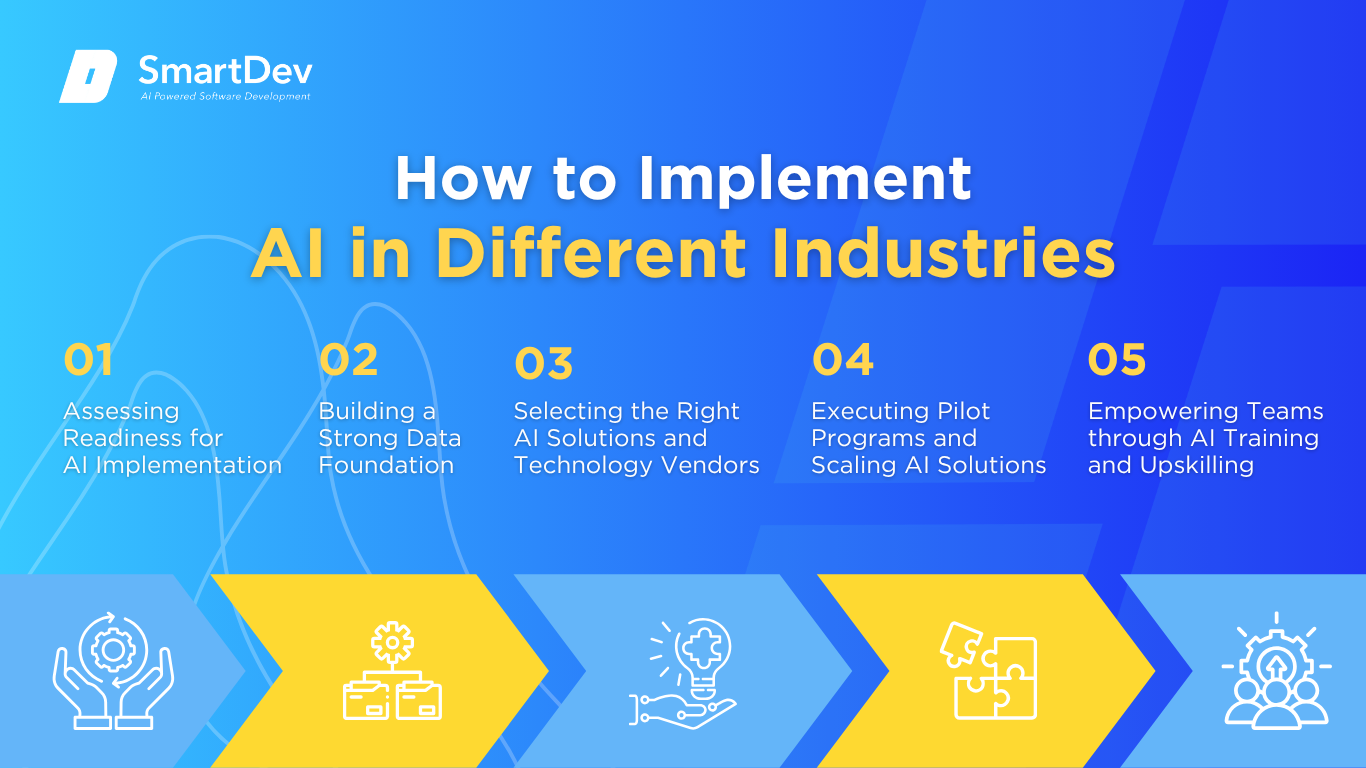
Step 1: Assessing Readiness for AI Adoption
Begin by pinpointing business workflows ripe for AI, clinician support in healthcare, trading optimization in finance, or predictive maintenance in manufacturing. Evaluate data readiness: health systems need structured EHR data; financial firms require clean transaction logs, and factories must log sensor output. These assessments shape realistic AI adoption roadmaps and prevent common pitfalls tied to poor data or infrastructure.
Step 2: Building a Strong Data Foundation
Structured data is the bedrock of effective AI. Healthcare systems should centralize EHR, claims, and diagnostic data while ensuring compliance with privacy standards. Financial firms need real-time data pipelines and normalized transaction histories. Manufacturers must collect consistent IoT sensor data and log maintenance events. Incorporating rigorous data governance and continuous pipelines ensures AI models are trained on accurate, trusted inputs.
Step 3: Choosing the Right Tools and Vendors
Define your specific needs such as diagnostic AI, trading agents, or supply-chain optimization and vet platforms accordingly. In healthcare, choose vendors experienced with HIPAA and FDA-approved models. Financial firms need secure, explainable AI platforms with real-time analytics capability. For manufacturers, select tools that integrate SCADA systems and support agentic AI for predictive maintenance. Engage partners who provide robust support, customization, and scalability.
Step 4: Pilot Testing and Scaling Up
Run pilots on defined use cases: e.g., AI radiology triage in one hospital wing, trader assistance tools in one desk, or predictive maintenance on a single production line. Evaluate accuracy, user acceptance, and cost savings before scaling. For instance, 1‑800Accountant launched a chatbot pilot that handled 65% of inquiries, saving agent time and confirming ROI before full adoption.
Step 5: Training Teams for Successful Implementation
Comprehensive training ensures employees understand AI’s role and trust its outputs. In healthcare, train clinicians on AI‑augmented diagnosis tools; in finance, empower analysts to interpret model signals; and in manufacturing, train staff to monitor AI agent alerts. Emphasize AI as augmentation, not replacement, nurturing collaboration and confidence.
Measuring the ROI of AI in Different Industries
Key Metrics to Track Success
Measuring the return on investment (ROI) of AI across industries involves assessing a blend of operational efficiency, cost reduction, and user experience improvements. In healthcare, for instance, AI can dramatically enhance productivity by automating administrative tasks like patient data entry, diagnostics triage, and billing verification. This streamlines workflows for clinicians, allowing them to dedicate more time to direct patient care, ultimately improving health outcomes and reducing burnout.
Cost savings is another central metric. AI-driven predictive maintenance in manufacturing reduces equipment downtime and prevents costly failures, while AI tools in finance detect fraud faster, avoiding substantial financial losses. For retail, dynamic pricing and inventory optimization reduce waste and increase margins.
Across sectors, KPIs such as task completion times, error rates, operational throughput, and customer satisfaction (CSAT) scores provide measurable evidence of AI’s effectiveness. A sustained improvement in these areas often translates into long-term ROI through better efficiency, customer retention, and reduced churn.
Case Studies Demonstrating ROI
AI is already delivering measurable values across multiple sectors. In healthcare, Mayo Clinic uses AI-powered radiology tools to accelerate the detection of critical conditions like strokes and cancer. By cutting diagnostic times significantly, these tools not only save lives but also reduce costs associated with late-stage treatments and readmissions.
In finance, JPMorgan Chase’s COiN platform uses AI to analyze complex legal documents, something that used to take 360,000 hours of manual labor. By automating this process, the bank significantly lowered costs and improved accuracy, showcasing the transformative power of AI on operational scalability. Meanwhile, in manufacturing, Siemens integrated AI into its predictive maintenance systems and reported a 25% decrease in unplanned downtime, which directly impacted production efficiency and cost control.
These examples clearly show that, when implemented strategically, AI not only reduces operational expenses but also enhances service reliability and decision-making speed – key factors in delivering sustainable ROI.
Common Pitfalls and How to Avoid Them
Despite its promise, achieving positive ROI from AI is not guaranteed. One common mistake is investing in AI without a well-defined use case or clear business objective. Organizations often deploy AI as a trend-following move rather than a solution to a specific problem, leading to underwhelming results. To avoid this, businesses should align AI initiatives with measurable goals tied to productivity, cost savings, or customer experience.
Another frequent challenge is inadequate data infrastructure. AI models are only as good as the data they’re trained on – messy, incomplete, or siloed data can severely compromise performance. Ensuring data quality through cleansing, normalization, and governance is essential for reliable AI outputs.
Additionally, some companies underestimate the importance of user adoption. Developing training programs that highlight AI’s role as a collaborator, not a replacement, helps ease transitions and build trust.
Future Trends of AI in Different Industries

Predictions for the Next Decade
In the next ten years, AI will move from enhancement to central command across industries, transforming how businesses operate, compete, and deliver value. In healthcare, AI will shift from assisting in diagnostics to fully supporting personalized medicine, with genomic-based treatment plans and AI-managed care pathways becoming the norm. Finance will evolve from AI-supported analysis to autonomous financial advisors that learn and adapt to client behavior in real time.
Manufacturing will see the rise of lights-out factories, where AI coordinates entire production lines with minimal human intervention. Predictive analytics and generative design will converge, enabling systems to both detect potential failures and engineer solutions on the fly. Retail will lean further into hyper-personalization, using AI to dynamically adjust pricing, product offerings, and marketing in real time based on customer sentiment, behavior, and market signals.
Across the board, AI will be embedded into digital twins, smart ecosystems, and edge computing, enabling real-time, autonomous decision-making with minimal latency. These trends point toward a future where AI is not just a tool—but a co-pilot in business strategy, operations, and innovation.
How Businesses Can Stay Ahead of the Curve
To keep pace with AI’s evolution, businesses need to prioritize agility and foresight. This starts with creating a data-centric culture where every decision is informed by real-time, clean, and actionable insights. Leaders must invest in cross-functional AI teams that bring together domain experts, data scientists, and IT professionals to ensure that AI solutions align with business goals.
Proactive upskilling is non-negotiable—companies that cultivate AI fluency across departments will outpace those that silo innovation in R&D. Embracing explainable AI and robust governance frameworks is equally critical, especially as regulations tighten and public scrutiny grows.
Partnerships with AI vendors, academic institutions, and think tanks will give businesses early access to innovations and best practices. Above all, companies must treat AI not as a short-term fix but as a long-term strategic investment—layered into every facet of operations, from customer experience to supply chain optimization.
Conclusion
Key Takeaways
AI is no longer a niche capability; it’s a transformative force across healthcare, finance, manufacturing, and retail. From improving diagnostic accuracy to predicting market shifts and optimizing factory operations, AI is driving measurable gains in productivity, cost efficiency, and customer satisfaction. Its versatility and scalability make it a powerful tool for organizations aiming to modernize their operations and lead in their sectors.
But realizing the full potential of AI requires more than just investment. Success depends on strategic implementation, grounded in solid data infrastructure, targeted pilot programs, and a well-trained workforce that understands how to collaborate with AI tools. As demonstrated by real-world case studies, when done right, AI delivers strong ROI and turns everyday operations into sources of competitive advantage.
Moving Forward: A Strategic Approach to AI in Different Industries
Now is the time for action. If your organization hasn’t started exploring AI or is stuck in pilot purgatory, it’s time to take the next step. Start by identifying high-impact areas for AI integration, investing in your data foundation, and building a cross-functional team to champion innovation.
At SmartDev, we help businesses navigate the complexities of AI adoption with end-to-end strategies; whether you’re in healthcare, finance, manufacturing, or retail. From solution selection and pilot testing to full-scale implementation and training, our experts are here to help you unlock measurable ROI and long-term resilience.
Reach out today and discover how AI can future-proof your business and turn disruption into opportunity. The AI era isn’t coming; it’s already here. Let’s help you lead it.
—
References:
- AI for Payments: Efficiency and Fraud Reduction | JPMorgan
- Amazon Rufus: AI Shopping Assistant | About Amazon
- AI-Based Predictive Maintenance | Siemens
- AI in Healthcare | IBM
- Foxconn CSR Event: AI and Smart Manufacturing
- AI Customer Support Guide for Small Businesses | Vodafone UK
- AI in Healthcare: Review Article | PMC
- How AI Drives More Affordable Credit Access | Upstart
- Haier’s AI Evolution: Charting the Course for GE Appliances | Forbes
- Walmart’s AI-Powered Inventory System Brightens the Holidays | Walmart Global Tech
- Enterprise AI Growth Driven by Early Adopters | IBM Newsroom







